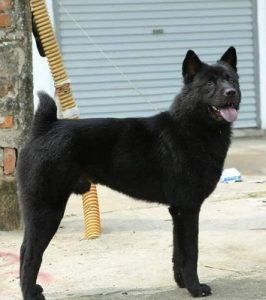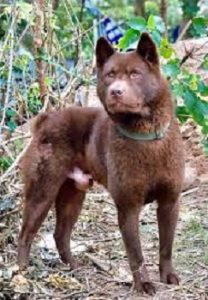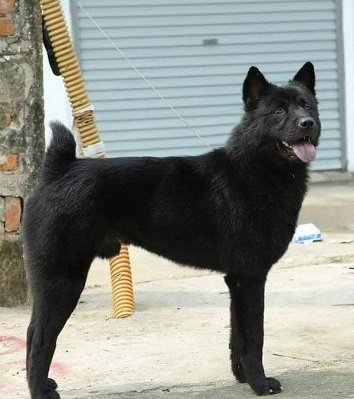Most people found this name unique, and have never heard about this dog breed, while the ones who know about it always want to gather more information. The Hmong dog belonged to the Hmong tribe in previous times, which means it is an ancient dog breed. In the mountainous areas of Northern Vietnam, the dog breed has quite a popularity, and now it is getting famous in other areas of the world as well.
How did the dog originate? That’s an interesting question but the answer is even more. A jungle wolf was bred with a dog, and the breed that was produced as a result was named as Hmong dog, after the tribe. People of Hmong considered this dog as their vital companion, and the dog was famous due to its hunting instincts.
Do you want to know more about this breed? We know this is why you’re here! Let’s get started!

| Traits | Hmong Dog |
| Weight | 35 to 55 pounds |
| Height | 18 to 22 inches |
| Lifespan | 15 to 20 years |
| Coat Color | White, brindle, brown, black |
| Coat texture | Thick and rough |
| Health concerns | Tick-borne disease, Diarrhea |
| Grooming | Requires regular brushing and occasional bathing |
| Trainability | Easy |
| Intelligence | Excellent memory, very intelligent |
| Activity level | High |
Appearance of the Hmong dog:
The Hmong dog is a muscular dog with having strong body and strength. The most prominent feature of this dog is that it has a docked tail. A squishy face is what makes it look cute and attractive to many people.
Moreover, the dog has concave streaks along its spine which enhances its beauty. The flexible, strong, and wide back lets the dog move easily and comfortably. Well-developed ribs, toned body, wide chest, are some of the other physical traits of the dog which make them look great.

Size of Hmong dog:
Talking about the size of the dog, it is neither too big nor very small, but a medium-sized body makes it ideal for pet owners. Depending upon the gender of the dog, as the male is bigger than the female, it weighs 35 to 55 pounds whereas the height ranges from 18 to 22 inches.
The tail is almost invisible, but if it is, it is around 3 to 5 centimeters long. This trait makes the Hmong dog unique from other dogs.
Coat and Coat colors of the Hmong dog:
The coat of the Hmong dog is a bit rough, but it is evenly erect. The coating density is quite thick which makes these dogs perfect for cold regions, especially the northwest of Vietnam.
The possible coat colors include white, brindle, brown, and black. But there is an exception, where the dog becomes a lot expensive. If the dog coat is anyhow brownish red, get ready to spend a lot of your savings.

Working side of the dog:
Do you know these dogs can serve as working dogs as well? Yes right! As these dogs are highly intelligent and respond well to training, they can be used for many purposes. Most commonly, the dogs are used by Vietnamese police to sniff and detect at the borderline for the safety of the country.
Are the Hmong dogs rare?
Yes! The reason that most of you haven’t heard about this dog breed is that not only are they not very common, but also one of the rarest breeds in the world. You can only find the dog in the Asian regions of the world, and being rare, they will cost you a heavy amount.
Personality of the Hmong dog breed:
The intelligence of the dog entirely describes its personality. Yes! The Hmong dogs are very intelligent, yet they have a strong memory. Their intelligence makes it easy for you to train the dog yourself.
Just tell them what to do a few times, and they will learn that thing rapidly. About the memory of the dog, it is very strong as well. Not only do they remember things, but they use their memory to learn different things.
Whether it is the direction to your house or any other way, the dog can simply find its way to the destination, thanks to its sublime memory. Many owners have tested that if they travel about 6 to 7 miles away with the dog, the dog can go back all that way just on its own.
The dog has a friendly nature which makes them affectionate towards its owner, but that requires proper training and early socialization. Lastly, loyalty is what you can expect from the dog without any doubts.
Health Concerns of the dog:
The strong Hmong dogs can adjust in multiple environments, as their enduring nature makes them resistant to health issues. But just like every other dog, this one can get some health issues as well.
Cold environment:
As most of these dogs live in a very cold environment, they can get a little tense in the initial days. The cool environment may be uncomfortable for them, but with time, the dog gets used-to to the climate.
If you feel that the dog isn’t easy in such a cold place, the ideal solution is to bring it to a hot place, where it cannot feel any discomfort and get resistant to catching a cold. But in the hot areas, the fluid requirement of the dog increases, so never forget to offer plenty of water to the dog.
Tick-Borne diseases:
Some pet owners don’t shower their dogs due to the cold environment, but this unhygienic lifestyle can cause various diseases in them. The most common one that this dog can suffer from is a tick-borne disease.
So don’t avoid giving a bath to your dog, but try to keep him clean and hygienic to prevent infections. Opt for lukewarm water instead of cold water to carefully bathe the dog.
Nutritional Requirement of the dog:
The diet of a dog plays a very important role in its well-being and maintenance of proper weight. The amount of food a dog requires every day depends on multiple factors including size, age, and gender of the dog.
Female dogs usually weigh less as compared to male dogs that is why their feeding requirement is less than the male ones. Also, the pups are small in comparison to adult dogs so they need a little diet.
But the pet owner should take proper care of the dog’s diet as it plays a crucial role when the dog is young and in its growing age. The diet should be sufficient, given in portions, quality-wise perfect, and hygienic for your pooch.
Another thing that is very important when it comes to the Hmong dog’s diet is that it should be cooked. Why is that so? The answer is simple! The Hmong dogs have a weak digestive system which makes it a bit risky that they might tolerate raw food or not. So to avoid any GIT issues or diarrhea, make sure the food is properly cooked.
Additionally, you don’t always have to focus on quantity; just make sure that the diet is nutritious. If the nutritional requirement of the dog is fulfilled by a small quantity, you don’t have to over-feed the dog. However, if the meal is less nutritious, opt for other healthy options.
When a dog gets adult, you can introduce foods like raw meat, rice, veggies, to bring diversity in its diet as, till that time the dog gets strong enough to tolerate raw food. But it is always good to check once before changing the diet patterns.
What if your dog eats enough food, but isn’t getting any healthy? That could be worms! The worms inside your dog’s body absorb some of the nutrients from the dog’s diet and this can lead to nutrient deficiency in the Hmong dogs.
To avoid such an issue, we recommend taking your dog to the vet every 6 months for deworming. This will reduce the risks of getting the health of the dog compromised and keep the dog safe and sound.

Physical activity of the Hmong dogs:
The Hmong dogs usually go with their owners for hunting purposes, climbing mountains, or searching in woods and jungles. This explains that these dogs are active and require sufficient physical activity for maintaining good health and temperament.
The movement of the dog is quite quick and skillful, thanks to its medium-sized body. So, with such an efficient movement, the dog can simply climb mountains, walk through jungles, or do whatever they want to do.
Well, if any of you are planning to have this dog as your home companion, get this straight that keeping it in a crate for too long will never be good for both of you. Hmong dogs are playful and you should spend most of the time playing with them, both indoors, and outdoors.
Let the dog do at least 40 minutes to 1 hour of vigorous activity to stay active and happy. What happens if you don’t do it? If you don’t let your dog be active, this is going to bring negative changes to its personality. Boredom can bring aggression and a sense of destroying things in the house, a sign of separation anxiety.

Grooming of the Hmong dog:
No matter what breed, every dog requires proper care to maintain good health and hygiene. In the case of the Hmong dog, you know that it has a thick coat which means grooming is quite necessary for it.
The dog’s coat can withstand all the weather from winters to summers, and from rainy to snowy, thanks to the nourishing and protective grease on its coat. How to know the right time to bathe a Hmong dog? Let’s see!
Whenever your dog smells bad and has some dirt on its coat, this indicates that it requires proper bathing. Don’t bathe the dog from too warm or too cold water, just let it be moderate.
Moreover, don’t let the coat of the dog wet for a long time after bathing it as it may help in catching a cold. We recommend you use a hairdryer to dry the thick coat of the Hmong dog after some time when it takes a bath.
When your dog comes back from playing outside the house, there is a chance it might have caught some lice or ticks from other dogs. Ticks and lice always attract towards a thick coat, so you have to be careful. Always check the dog’s coat, and clean it to ensure maximum cleanliness and reduce the risk of diseases.
Besides the coat, always brush the coat regularly to avoid tangling of hair, as the coat is already not very smooth or thin. Keep the ears of the dog clean, and brush the teeth regularly to keep the dental problems away. Lastly, don’t forget to clip the nails when it’s necessary.

Lifespan of Hmong dogs:
The Hmong dogs have high endurance and strength which makes them strong enough to face all circumstances. They don’t suffer from a lot of diseases, and in the same way, don’t inherit much of them.
Also, the dog doesn’t have any allergies, so in a nutshell, Hmong dogs are quite easygoing. So, the average lifespan of a Hmong dog is around 15 to 20 years, but it entirely depends on the care you offer the little pooch being an owner.
To increase the lifespan, even more, don’t forget to visit the vet regularly, and offer an adequate and quality diet to the dog.
Trainability of Hmong dog:
Some people think that the fact that Hmong dog’s ancestors are wolves makes it less easy to train and serve the owners. But that’s not true! They are quite easy to train due to their high intelligence and they also help the owners in their daily chores.
As they have loyalty in their personality, they can look after the things of their owner including his house. Also, they have hunting instincts and that’s what they have got from their wolf ancestors. In past years, these dogs have faced a lot of scary creatures, thanks to their bravery and excellent personality.
But these aren’t the things for which the Hmong dog is trained nowadays. In the present age, people train these dogs to be house dogs and family dogs. The pet owners train these dogs for fetching, potty training, basic obedience, and especially picking up things for some help.
Besides, the Vietnamese people train them how to detect something by sniffing so that these dogs can be quite a help at the border.
Bottom Line:
The Hmong dogs are strong, enduring, and active dogs used for several purposes. The most interesting thing about these dogs is that they have a very sharp memory and can remember directions up to 6 to 7 miles. Also, you can train them easily without the need of a professional trainer, all thanks to their intelligence.

